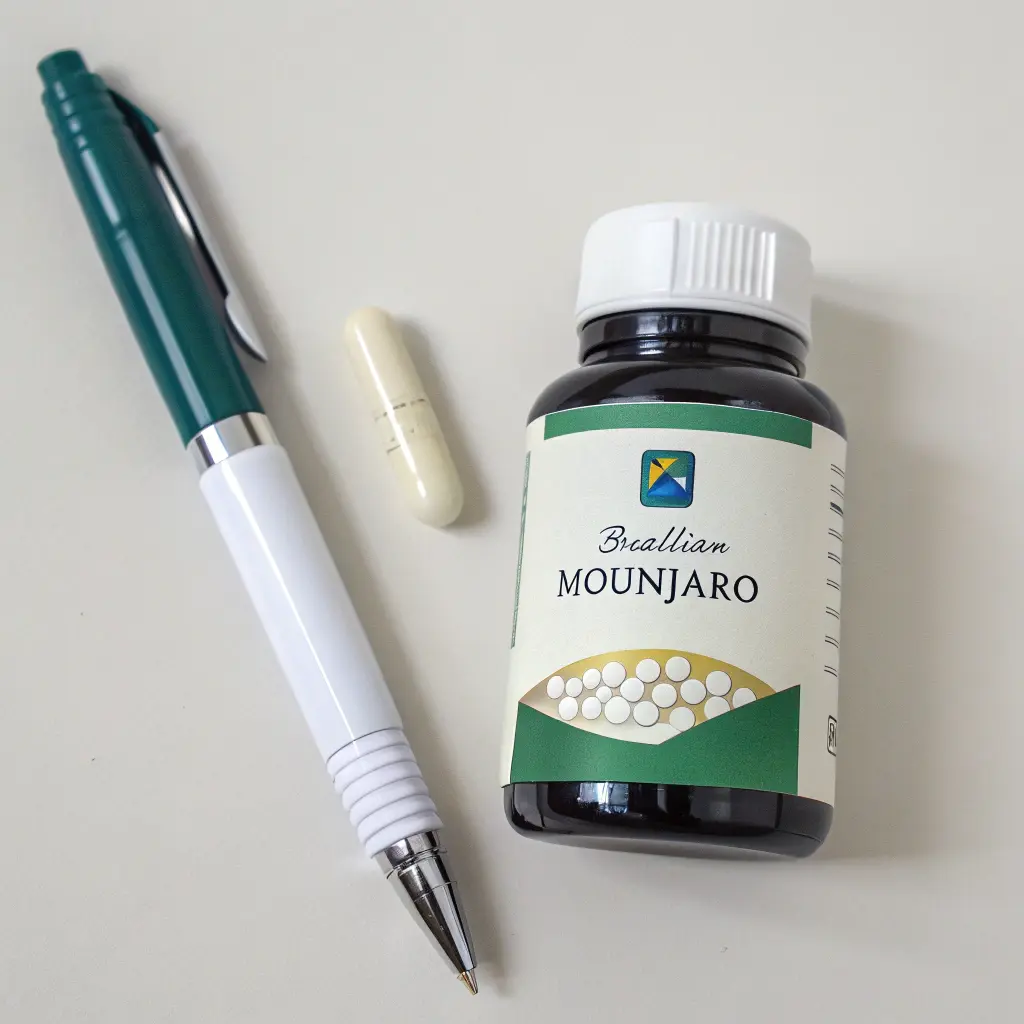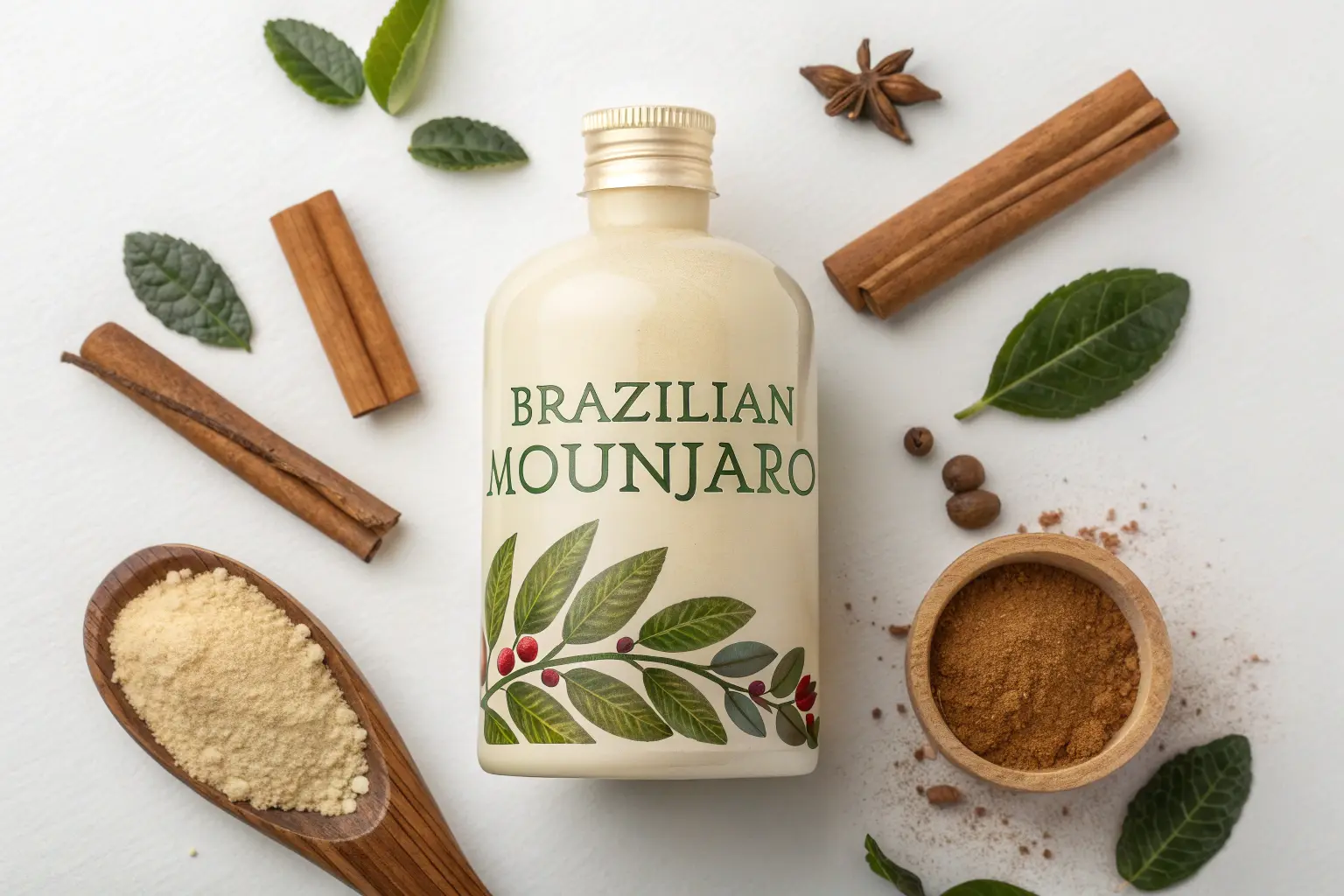Alright, so you’ve probably seen Brazilian Mounjaro pop up all over your feed maybe in a “this changed my life” TikTok, or someone at work swears by it after dropping 10 pounds without giving up Taco Tuesday. And now you’re sitting there like, “What is Brazilian Mounjaro Made Of ?” , “What the heck is this stuff… and is it legit?”
I gotchu.
Brazilian Mounjaro isn’t some weird pharmaceutical injection you need a prescription for. Nope. It’s a natural supplement one that’s been trending hard because of its so-called ability to help with weight management, sugar cravings, and energy levels. But before we start making big claims, let’s break it all the way down:
– What’s in it?
– How’s it different from the Mounjaro you hear about at the doctor’s office?
– And does it actually do anything… or is it just good marketing?
Let’s dig in and keep it real ingredient by ingredient, no fluff, no hype.
So… What Even Is Brazilian Mounjaro?
First things first: Brazilian Mounjaro is a plant-based supplement, not a prescription drug.
It’s being marketed as a “natural alternative” to Tirzepatide aka the injectable med sold under the name Mounjaro, which was originally approved for Type 2 diabetes and is now in the spotlight for helping people shed serious pounds.
But this Brazilian version? Completely different. It’s not a drug, doesn’t require a prescription, and comes in pill or capsule form (usually herbal-style supplements). Its main pitch is that it mimics some of the benefits of GLP-1 drugs like Mounjaro, but with all-natural ingredients some of which have roots in traditional herbal medicine.
What Brazilian Mounjaro Is Made Of vs Prescription Mounjaro (Tirzepatide)
Let’s clear this up right away: Brazilian Mounjaro is NOT the same thing as the real-deal Mounjaro injection your doc might prescribe.
- Prescription Mounjaro (Tirzepatide): A synthetic GLP-1 agonist. You inject it once a week. It works by slowing down digestion, curbing appetite, and regulating blood sugar. It’s FDA-approved.
- Brazilian Mounjaro: A mix of natural ingredients things like berberine, chromium, gymnema, and fiber-rich plants. It’s meant to support similar goals (blood sugar balance, appetite control), but it works differently. It’s more subtle, more holistic, and it won’t come with the same side effects or prescription hoops.
So yeah, it’s basically like comparing cold brew coffee to a Red Bull. Similar vibes, very different mechanics.
Why Everyone’s Talking About It
You know how trends go once something gets called “natural Ozempic” or “plant-based Mounjaro,” the internet loses its mind. That’s exactly what happened here.
Brazilian Mounjaro has gained serious traction thanks to:
- TikTok testimonials of people claiming they’ve dropped inches fast
- Wellness influencers swearing by its “gentle fat-burning”
- Curiosity from folks wanting some results without the injections or scary side effects
But listen marketing is one thing, actual ingredients are another. So let’s look under the hood and see what Brazilian Mounjaro is actually made of.
What is Brazilian Mounjaro Made Of? Full Ingredient List & Benefits
Now to the good stuff what’s actually inside this thing?

Unlike prescription Mounjaro, which is one synthetic compound (Tirzepatide), Brazilian Mounjaro is a blend of natural ingredients that target weight control, cravings, and energy support. It’s like the homemade version of a GLP-1, made with stuff your body already knows how to work with.
Brazilian Mounjaro Ingredients: What’s Inside and How It Works
1. Berberine Extract
Berberine is kinda the star of the show here. It’s a natural compound found in plants like barberry and goldenseal, and it’s been studied for its ability to:
- Lower blood sugar
- Improve insulin sensitivity
- Support weight loss, especially belly fat
It’s often called “natural metformin” for a reason. In fact, some studies say it works almost as well as the real thing for blood sugar management.
If you’re into natural swaps, this is right up there with stuff like homemade healthy desserts that taste indulgent but don’t wreck your diet.
2. Gymnema Sylvestre
Try saying that five times fast
This leafy herb from India is known for literally blocking the taste of sugar. (Yup, if you chew a gymnema leaf and then eat a piece of candy, it won’t taste sweet.)
In supplements, it helps with:
- Craving control
- Glucose regulation
- Curbing sweet tooth attacks (especially at night)
If you’re the type to sneak a cookie after dinner, this might actually help. Kinda like how a black bean soup fills you up in a hearty, satisfying way without the sugar bomb.
3. Chromium Picolinate
This trace mineral has been around the supplement world forever usually in fat burners, blood sugar helpers, and sometimes even mood boosters.
In Brazilian Mounjaro, it’s included to:
- Stabilize blood sugar
- Reduce hunger and mood swings tied to insulin dips
- Help your cells use glucose more effectively
Think of it like your metabolism’s little assistant, helping everything run smoother behind the scenes.
4. Apple Cider Vinegar Powder
You’ve probably already heard about this one. ACV has been trending for years in the health space, and for good reason.
In powdered form, it:
- Supports digestion
- Boosts metabolism
- Might help with fat burning (some evidence points to belly fat loss)
It’s gentler than taking shots of vinegar and a lot easier on your teeth and stomach. Plus, it fits well with gut-friendly meals like a cucumber salad or a baked salmon dish.
5. Glucomannan (Konjac Root)
This stuff is basically fiber magic.
Glucomannan comes from the root of the konjac plant and can absorb up to 50 times its weight in water. What does that mean for you?
- It expands in your stomach to help you feel full
- Slows digestion so you’re not snacky 10 minutes later
- Supports gut health and smooth digestion
It’s in a lot of appetite suppressant blends, and it can actually help with portion control if you’re trying to cut back without feeling hangry.
6. Yerba Mate or Guarana (Optional)
Some Brazilian Mounjaro blends throw in a little South American spice with yerba mate or guarana two natural stimulants packed with antioxidants and a gentle caffeine buzz.
Benefits include:
- Boosted metabolism
- Increased energy without the crash
- Mental clarity (yes, please )
If you’re the type to reach for a cold brew mid-afternoon, this might scratch that itch without the jitters.
Are Brazilian Mounjaro Ingredients Clinically Proven?
A bunch of them? Yes.
- Berberine, chromium, and glucomannan all have studies behind them.
- Gymnema has traditional use and some modern research.
- ACV has mixed studies, but plenty of anecdotal support.
Together, these ingredients make up a formula that’s definitely more “real-food-based” than lab-created kinda like swapping out boxed cornbread for something made from scratch. Way more satisfying.
How Brazilian Mounjaro Works in the Body to Support Weight Loss
Now that we know what’s inside this thing, let’s answer the big question:
How does Brazilian Mounjaro actually help with weight loss, cravings, and energy?
The truth is it’s not one single “active” ingredient doing all the work. It’s the combo of ingredients working together that gives it the edge. Here’s how they tag-team your body to help you feel more balanced (and possibly a little lighter on the scale).
Balancing Blood Sugar Levels
So here’s the deal with blood sugar: if it spikes and crashes all day, your energy’s all over the place, and cravings go nuts. That’s where ingredients like berberine, chromium, and gymnema come in.
They work together to:
- Keep glucose levels steady after meals
- Help insulin work more efficiently
- Avoid those “I need sugar NOW” moments
This is huge for weight management. When your blood sugar’s stable, your appetite naturally chills out. And that means you’re less likely to grab a sugary snack at 9 p.m. (been there, no shame).
Honestly, it reminds me of learning how not to mess up creamy desserts like when you’re making crème brûlée and the trick is all in the balance. Too hot, too fast? You’re done. Too much sugar in your bloodstream? Same deal for your body.
Suppressing Cravings + Reducing Appetite
Now let’s talk about that snacky gremlin that lives in your stomach.
Brazilian Mounjaro includes glucomannan, a soluble fiber that expands when it hits water. Basically, it fills you up so you feel satisfied longer after meals. Less grazing = fewer empty calories. Add in apple cider vinegar (which helps slow digestion) and you’ve got a combo that naturally reduces how often you think, “Should I eat something?”
Also, gymnema literally makes sugar taste less sweet. Wild, right? So if you’re someone who grabs a cookie every time you walk by the pantry, this might help dull that sweet tooth just enough to break the habit.
This effect is kinda like using thick fiber-rich ingredients in comfort food recipes like black bean soup or southern-style cornbread dressing. They’re hearty, they satisfy, and they help keep you full without blowing up your calorie count.
Gut Health, Digestion, and Metabolism
Let’s not forget the gut.
So many people forget that a happy gut = better digestion = more efficient fat-burning. The fiber (hello again, glucomannan), the ACV powder, and even the yerba mate/guarana (if included) all help in different ways:
- Improved digestion (less bloating, more regularity)
- Faster metabolism through thermogenic effects (aka your body working harder to process food)
- A slight boost in energy and mood, which let’s be honest, always helps when you’re trying to stay motivated
And for folks trying to avoid artificial energy drinks or sugar-loaded “fat burners,” this is a much more natural path. Think more sourdough bagel, less neon-colored diet shake.
Is Brazilian Mounjaro Made of Safe, Natural Ingredients?
You’re probably wondering if there’s a catch, right?
Here’s the good news: Most Brazilian Mounjaro blends are marketed as 100% natural, with no synthetic ingredients, no GMOs, and often even vegan and gluten-free.
BUT and this is a big one natural doesn’t always mean safe for everyone.
Side Effects to Know About
Common side effects (usually mild) might include:
- Bloating or gassiness (thanks to fiber)
- Slight stomach discomfort if taken on an empty stomach
- Jitters or headaches (if the formula includes caffeine-like ingredients like yerba mate or guarana)
These usually go away in a few days, but it’s worth mentioning.
Who Should Avoid It
Skip Brazilian Mounjaro if you’re:
- Pregnant or breastfeeding
- Dealing with major gut issues like IBS
- Taking meds for diabetes or thyroid unless your doctor says it’s cool
- Super sensitive to caffeine (and the blend includes yerba or guarana)
This is a great moment to remind readers that natural doesn’t mean harmless for everyone same way a sweet potato pie looks harmless until you eat three slices in one sitting. Been there too.
How to Take Brazilian Mounjaro Correctly
Alright, here’s the deal you can have the best ingredients in the world, but if you’re not taking them the right way, it’s like trying to bake a pie with the oven turned off. (Shoutout to sweet potato pie mishaps still healing from that experience.)
Most Brazilian Mounjaro supplements come in capsule form, and the general instructions look like this:
Daily Dosage
- 2 capsules per day is the most common serving size
- Usually taken once in the morning, or split between morning and afternoon
- Drink a full glass of water with it especially if it contains glucomannan (trust me, you want that fiber to expand in your belly, not your throat)
When to Take It
- Best taken 30 minutes before a meal, especially breakfast or lunch
- If it contains any kind of caffeine (like yerba mate or guarana), take it earlier in the day to avoid messing with your sleep
If you’ve ever meal prepped around ingredients like rotisserie chicken or sweet potato sides, you know that timing is everything. Same deal here.
Can You Stack It With Other Supplements?
You can, but be careful.
- Avoid stacking it with other strong appetite suppressants or blood sugar regulators (like berberine or chromium-based blends). You don’t want a blood sugar crash.
- If you’re already taking a multivitamin, fiber supplement, or ACV gummies double check the ingredients to avoid doubling up.
If you’re unsure, play it safe and keep it simple. Your body will thank you.
How Long Does Brazilian Mounjaro Take to Work?
This is one of the top questions folks are typing into Google nd yeah, it’s important. If you’re expecting overnight results, you might be disappointed. But if you’re in it for steady progress? This could be your jam.
Here’s what most users report:
First 1–2 Weeks
- You’ll likely start feeling less hungry, especially between meals
- Some users report better digestion, less bloating, more regularity
- If your blend includes caffeine: slight energy boost and better focus
After 3–4 Weeks
- Noticeable changes in appetite control
- Some people lose 3–7 lbs in the first month, especially when paired with light diet tweaks
- Cravings decrease especially late-night snacks or sweets
Keep in mind, this is not a prescription drug. You’re not going to melt fat in a week. But that’s also what makes it easier on your body, your wallet, and your long-term goals.
If you’re trying to stay full longer or avoid those 4 p.m. crash cravings, you’ll probably see a difference earlier than someone expecting a dramatic weight drop.
Think of it like cooking something low and slow like a southern casserole it takes time to do it right, but it hits harder in the end.
Brazilian Mounjaro Ingredients vs Prescription Mounjaro: What’s the Difference?

Now let’s talk about the elephant in the room how does Brazilian Mounjaro compare to the prescription stuff?
Let’s break it down:
Ingredients Comparison
| Brazilian Mounjaro | Prescription Mounjaro (Tirzepatide) | |
|---|---|---|
| Form | Capsules | Weekly injection |
| Main Ingredients | Berberine, ACV, fiber, chromium, gymnema | Synthetic GLP-1 & GIP agonist |
| Prescription Needed? | No | Yes |
| Natural? | Yes | No |
| FDA-Approved? | No (it’s a supplement) | Yes |
Effects and Results
- Brazilian Mounjaro: Mild to moderate weight support, helps manage cravings and blood sugar over time. Works with your body in a slower, natural way.
- Prescription Mounjaro: Clinical weight loss results, often used for medical weight loss with a doctor. Stronger appetite suppression, but comes with possible side effects (nausea, GI issues, etc.).
Bottom line? If you’re trying to stay off medications but still want help managing cravings and energy naturally Brazilian Mounjaro is a solid place to start.
Where Can You Buy Brazilian Mounjaro Safely?
So you’ve read the label, seen the results, and you’re ready to give this a go… but where the heck do you buy it without getting scammed?
Because real talk? There are a ton of sketchy listings out there. Some promise “miracle weight loss in 3 days” (red flag ), others are knock-offs with no ingredients listed. Here’s how to stay safe:
What to Look For:
- Transparent label: All ingredients listed with actual amounts
- Company website: A real, secure site with support info and verified reviews
- Third-party testing: Even though it’s not FDA-approved, the better brands will still show they’ve tested for quality
What to Avoid:
- No ingredient label = no-go
- Sites that only accept crypto or sketchy payment platforms
- Stock images or reviews that sound… fake (you know the ones)
And if you’re shopping online, double check the listing on Amazon or the brand’s official site. If it’s not clear what’s inside the bottle skip it.
Also, never trust a product promising results faster than cracking a creme brûlée with a spoon. If it sounds too good to be true, it probs is.
Natural Alternatives with Similar Ingredients
Not sure Brazilian Mounjaro is for you? No worries there are a few other natural blends that contain similar ingredients like berberine, apple cider vinegar, and glucomannan.
Here are a few alt-options worth looking into:
Berberine Standalone Supplements
- Great if your main concern is blood sugar control
- Often used by folks with insulin resistance or borderline prediabetes
Fiber + Appetite Control Blends
- Look for glucomannan, psyllium husk, or prebiotic fibers
- Helps you feel fuller longer, especially with small meals
Natural Mounjaro Recipe
If you’re more of a DIYer, you’ll love this Natural Mounjaro Recipe it’s a home-style version made from everyday ingredients that mimic the effects of the supplement (but with your own twist).

What is Brazilian Mounjaro Made Of?
Ingredients
Method
- Combine all dried ingredients in a large mixing bowl.
- Boil water and steep 1-2 tablespoons of the mix for 5–10 minutes.
- Strain and drink warm or chilled.
- Consume once or twice daily as part of a balanced diet and active lifestyle.
Nutrition
Notes
Tried this recipe?
Let us know how it was!Conclusion
So, after all that what’s the deal with Brazilian Mounjaro?
Here’s the truth: it’s not some miracle overnight fat burner, and it’s definitely not the same thing your doctor prescribes. But what it is? A plant-based, feel-good supplement that might actually help support your goals especially if you’re working on cutting cravings, improving energy, or managing blood sugar.
With ingredients like berberine, gymnema, ACV, chromium, and fiber-packed glucomannan, it’s got some solid tools behind it. And it’s natural, which is a big win for folks who aren’t ready to go the prescription route.
If you’re someone who’s tried to manage your weight without harsh chemicals or side effects, this is worth looking into. But as always real results come from real changes. Brazilian Mounjaro can support you, but you’re the one making it happen.
And if you want to keep it homemade, check out that Natural Mounjaro Recipe same vibes, pantry-style.
Stay curious, stay kind to your body, and keep those labels real.
FAQs: What is Brazilian Mounjaro Made Of? Plus Everything Else You’re Wondering
Is Brazilian Mounjaro FDA-approved?
Nope! It’s not FDA-approved because it’s a **dietary supplement**, not a pharmaceutical. That means it isn’t evaluated or regulated the same way prescription drugs are.
Does it work like prescription Mounjaro?
Not exactly. Brazilian Mounjaro uses plant-based ingredients to support appetite control and blood sugar balance. It doesn’t work as fast or as powerfully as Tirzepatide (the real deal), but it’s a good fit for folks wanting a **natural alternative**.
Is it safe for long-term use?
For most people, yes — especially if it’s taken at the recommended dose and your doc gives the green light. Since it’s made from herbs and fiber, it’s generally safe, but listen to your body and cycle off if needed.
What’s the best time to take it?
Right before a meal — usually **30 minutes before breakfast** is the best time to get those appetite-curbing effects going before your first bite.
Can I take it while on medication?
This is where you check with your doc. Especially if you’re on meds for blood sugar or blood pressure — some ingredients like berberine and chromium can interact with those.
Is it really made in Brazil?
Not always. Some brands use the word “Brazilian” for marketing, while others *are* manufactured or inspired by traditional herbal blends from Brazil. Always check the label for the actual country of origin.
